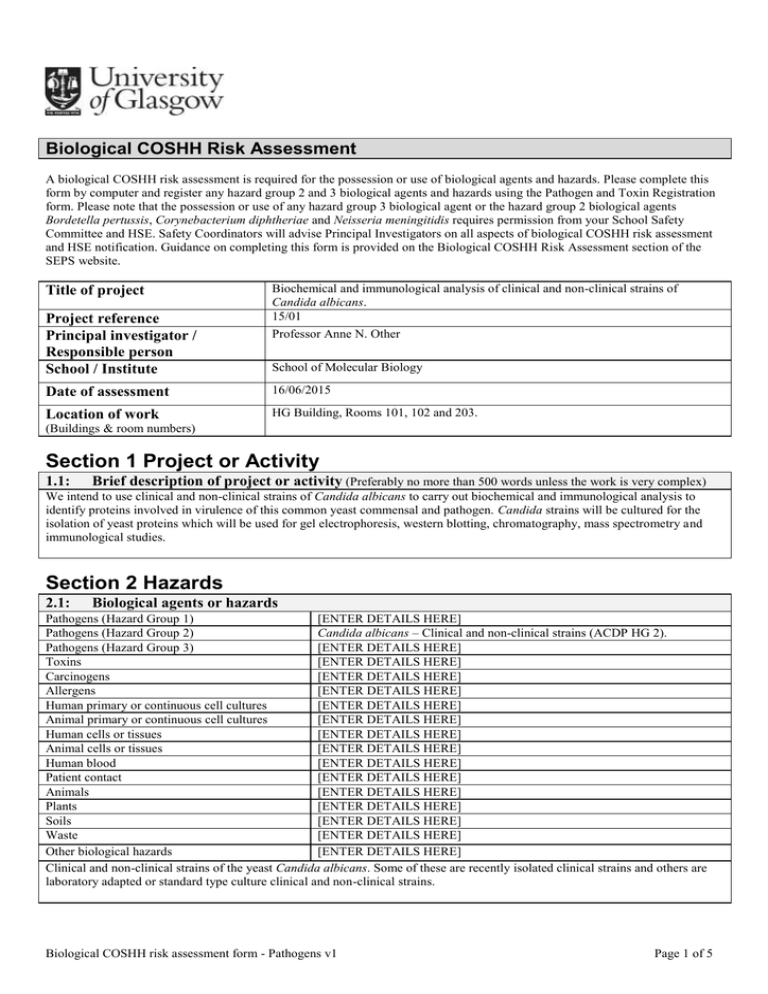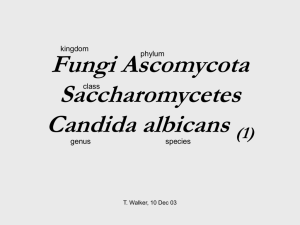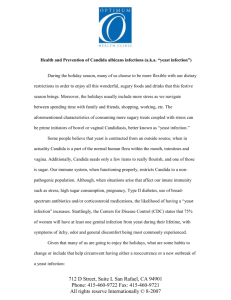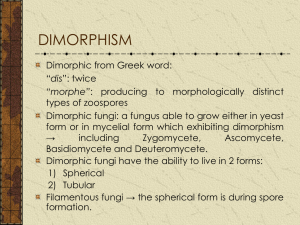Biological COSHH Risk Assessment
advertisement

Biological COSHH Risk Assessment A biological COSHH risk assessment is required for the possession or use of biological agents and hazards. Please complete this form by computer and register any hazard group 2 and 3 biological agents and hazards using the Pathogen and Toxin Registration form. Please note that the possession or use of any hazard group 3 biological agent or the hazard group 2 biological agents Bordetella pertussis, Corynebacterium diphtheriae and Neisseria meningitidis requires permission from your School Safety Committee and HSE. Safety Coordinators will advise Principal Investigators on all aspects of biological COSHH risk assessment and HSE notification. Guidance on completing this form is provided on the Biological COSHH Risk Assessment section of the SEPS website. Title of project Project reference Principal investigator / Responsible person School / Institute Biochemical and immunological analysis of clinical and non-clinical strains of Candida albicans. 15/01 Professor Anne N. Other School of Molecular Biology Date of assessment 16/06/2015 Location of work HG Building, Rooms 101, 102 and 203. (Buildings & room numbers) Section 1 Project or Activity 1.1: Brief description of project or activity (Preferably no more than 500 words unless the work is very complex) We intend to use clinical and non-clinical strains of Candida albicans to carry out biochemical and immunological analysis to identify proteins involved in virulence of this common yeast commensal and pathogen. Candida strains will be cultured for the isolation of yeast proteins which will be used for gel electrophoresis, western blotting, chromatography, mass spectrometry and immunological studies. Section 2 Hazards 2.1: Biological agents or hazards Pathogens (Hazard Group 1) [ENTER DETAILS HERE] Pathogens (Hazard Group 2) Candida albicans – Clinical and non-clinical strains (ACDP HG 2). Pathogens (Hazard Group 3) [ENTER DETAILS HERE] Toxins [ENTER DETAILS HERE] Carcinogens [ENTER DETAILS HERE] Allergens [ENTER DETAILS HERE] Human primary or continuous cell cultures [ENTER DETAILS HERE] Animal primary or continuous cell cultures [ENTER DETAILS HERE] Human cells or tissues [ENTER DETAILS HERE] Animal cells or tissues [ENTER DETAILS HERE] Human blood [ENTER DETAILS HERE] Patient contact [ENTER DETAILS HERE] Animals [ENTER DETAILS HERE] Plants [ENTER DETAILS HERE] Soils [ENTER DETAILS HERE] Waste [ENTER DETAILS HERE] Other biological hazards [ENTER DETAILS HERE] Clinical and non-clinical strains of the yeast Candida albicans. Some of these are recently isolated clinical strains and others are laboratory adapted or standard type culture clinical and non-clinical strains. Biological COSHH risk assessment form - Pathogens v1 Page 1 of 5 Section 3 Risks 3.1: Human, animal or plant diseases or conditions or environment damage associated with biological agents or hazards Candida albicans is a common human commensal and pathogenic yeast. It can cause cutaneous, sub-cutaneous and systemic infections. Most infections are minor but it can cause serious infections particularly of individuals who are immunosuppressed or immunodeficient. 3.2: Potential routes of exposure to humans, animals or plants or release to environment Select all that apply Inhalation Ingestion Injection Absorption Other The most significant potential routes of exposure to Candida albicans are from the absorption or ingestion routes, but other routes of exposure could also be significant depending on the strain and circumstances. Direct contact with the yeast can cause skin infection which could lead to peripheral or systemic infections. The risks of infection by aerosols are very low for healthy individuals. 3.3: Use of biological agents or hazards Small scale Medium scale Large scale Fieldwork Animals Plants Other Select all that apply We intend to use clinical and non-clinical strains of Candida albicans to carry out biochemical and immunological analysis to identify proteins involved in virulence of this common commensal and pathogen. Candida strains will be cultured in small quantities for the isolation and analysis of yeast proteins. This will involve solid and liquid culture of yeast, centrifugation, microbiological safety cabinets, microscopy, gel electrophoresis, western blotting, chromatography, mass spectrometry and immunological studies. 3.4: Frequency of use Daily Week Monthly Other Candida albicans yeast strains will be used every day of the week. 3.5: Select one Maximum amount or concentration used Negligible Low Medium High Select one Candida albicans strains will be grown in small quantities in solid cultures on petri dishes and liquid cultures in flasks and tubes of volumes up to 1 litre. 3.6: Levels of infectious aerosols Negligible Low Medium High Select one Some aspects of the culturing and handling of these Candida albicans strains will involve the generation of aerosols especially the liquid culture and pipetting of yeast. 3.7: Potential for exposure to biological agents or hazards Negligible Low Medium High Select one The potential for exposure to the Candida albicans yeast is significant since fairly large quantities of yeast especially in liquid cultures but also solid cultures are grown up and handled on the bench but the risks of harm to most individuals are generally very low. 3.8: Who might be at risk (*If you need advice contact the University Occupational Health Service) Staff Students Visitors Public Young people (<18yrs) *New and expectant mothers The main risks will be to those doing the work and to other users of the lab and storage facilities. Other 3.09: Assessment of risk to human health (Prior to use of controls) Level of risk Effectively zero Low Medium/low Medium High Select one Medium High Select one 3.10: Assessment of risk to environment (Prior to use of controls) Level of risk Effectively zero Low Medium/low Section 4 Controls to Eliminate or Reduce Risks 4.1: Containment Laboratory Animal facility Plant facility Biological COSHH risk assessment form - Pathogens v1 Other Select all that apply Page 2 of 5 4.2: Containment level Containment level (CL 1) Containment level (CL 2) Containment level (CL 3) All Candida albicans strains will be handled and stored at containment level 2 (CL2). 4.3: Select one Microbiological safety cabinets (MSC) Class 1 Class 2 Class 3 Other Select all that apply Most of the work with this yeast will be done on the bench. All work which might generate significant infectious aerosols such as where large quantities of liquid culture are handled will be carried out inside a microbiological safety cabinet. The surfaces of the microbiological safety cabinet will be disinfected with 1% Virkon after use. 4.4: Sharps controls The use of sharps will be avoided unless there is no suitable alternative in which case safe work practices will be used to prevent sharps injuries which might lead to exposure to pathogens. Hands will be washed after the work activity is completed. 4.5: Other controls 4.6: Personal protective equipment (PPE) Lab coat Lab gown Surgical scrubs Disposable clothing Apron Spectacles Goggles Face shield Gloves Special headwear Special footwear Other Lab coats, disposable nitrile gloves and spectacles will be worn to carry out this work. 4.7: Respiratory protective equipment (RPE) Disposable mask Filter mask Powered respirator Breathing apparatus Not required. 4.8: Select all that apply Half face respirator Other Full face respirator Select all that apply Storage of biological agents or hazards All Candida albicans yeast strains and samples will be properly stored using suitable containers for microorganisms and their products. Yeast strains, samples, products and sample tubes will be stored inside suitable containers or boxes inside fridges and freezers. 4.9: Transport of biological agents or hazards Internal transport of clinical samples will be carried out using leak proof primary containers. The primary container will then be placed inside a pathology medical bag or other robust container for safe transport of the materials. External transport from the hospital to the University of clinical samples will be classified as Category B infectious substances and carried out using UN approved packaging systems and a pathology medical bag for safe transport of the materials. External transport by postal service of clinical samples will be classified as Category B infectious substances and carried out using UN approved packaging systems and an approved dangerous goods carrier. 4.10: Inactivation of biological agents or hazards Disinfection Autoclave Fumigation Incineration Other Disinfection and autoclaving will be carried out where required. All waste materials will be disposed of into the autoclave bags, yellow clinical waste bags or sharps bins as required. All used sharps will be placed immediately after use into a sharps bin. Sharps bins will be located on the bench where the sharps are used so that they can be disposed of directly after use. All Candida albicans infected waste will be autoclaved before disposal. a) Disinfection. 1% Virkon will be used for disinfection. The surfaces of the microbiological safety cabinet will be disinfected with 1% Virkon after use. Laboratory benches will be swabbed with 1% Virkon after any activity. b) Autoclaving. All contaminated materials, including waste destined for incineration, will be inactivated by autoclaving (100% kill) prior to disposal of waste or cleaning and recycling of reusable laboratory equipment, such as glassware. Autoclaves will be validated by annual thermocouple mapping and each run will be monitored by continuous chart (or digital) recording of the temperature/time profile. Biological COSHH risk assessment form - Pathogens v1 Page 3 of 5 Or All contaminated materials, including waste destined for incineration, will be inactivated by autoclaving (100% kill) prior to disposal of waste or cleaning and recycling of reusable laboratory equipment, such as glassware. Autoclaves will be validated by annual thermocouple mapping and each run will be monitored using TST (Time, Steam, and Temperature) test strips (Albert Browne Ltd., TST class 6 emulating indicator 121ºC for 20 min). 4.11: Waste disposal All waste materials will be treated as hazardous waste. 4.12: Health surveillance or immunisation (If you need advice contact the University Occupational Health Service) Not required for this work. 4.13: Instructions, training and supervision All workers will be properly trained and monitored by the principal investigator and suitably qualified laboratory supervisors and no worker will be allowed to work unsupervised in the laboratory until they are suitably and sufficiently trained. Training procedures, which include information on hazards and risks and control measures to be used. Copies of all risk assessments and standard operating procedures will be kept in the laboratory and reviewed regularly and immediately if there are any changes to the risks or the nature of the work. All workers will be appropriately trained in procedures and safe work practices. All workers will be appropriately supervised until they are competent to safely perform unsupervised all aspects of the work including the emergency procedures. Access to the lab is restricted to personnel approved by the principal investigator. The principal investigator Professor A. N. Other and senior members of the research group will monitor activities to ensure that all control measures are properly implemented and all workers are suitably trained and competent to safely perform the work in the CL2 laboratory. 4.14: HSE notification and consent where required Not required for this work. 4.15: Scottish Government or DEFRA Animal Health, Plant Health or other licence where required Not required for this work. Section 5 Emergency Procedures 5.1: Emergency procedures Spillages of any Candida albicans or any of their contaminated products will be disinfected with 1% Virkon. In the event of any injection injury or other serious accidental exposure seek first aid or medical attention if required. 5.2: Emergency contacts Name Prof A. N. Other Dr J. G. Jones Position Principal Investigator Research Fellow Telephone 0141 259 4072 0141 259 4063 Signature Jack Jones Date 16/06/2015 Section 6 Approval 6.1: Assessor Name Dr J. G. Jones 6.2: Principal investigator / Responsible person Name Prof A. N. Other Signature Anne Other Date 16/06/2015 Risk Estimation Matrix Consequence of hazard Likelihood of hazard Biological COSHH risk assessment form - Pathogens v1 Page 4 of 5 Severe Modest Minor Negligible High Medium Low Negligible High High Medium / Low Effectively zero High Medium Low Effectively zero Medium Medium / Low Low Effectively zero Effectively zero Effectively zero Effectively zero Effectively zero Biological COSHH risk assessment form - Pathogens v1 Page 5 of 5





